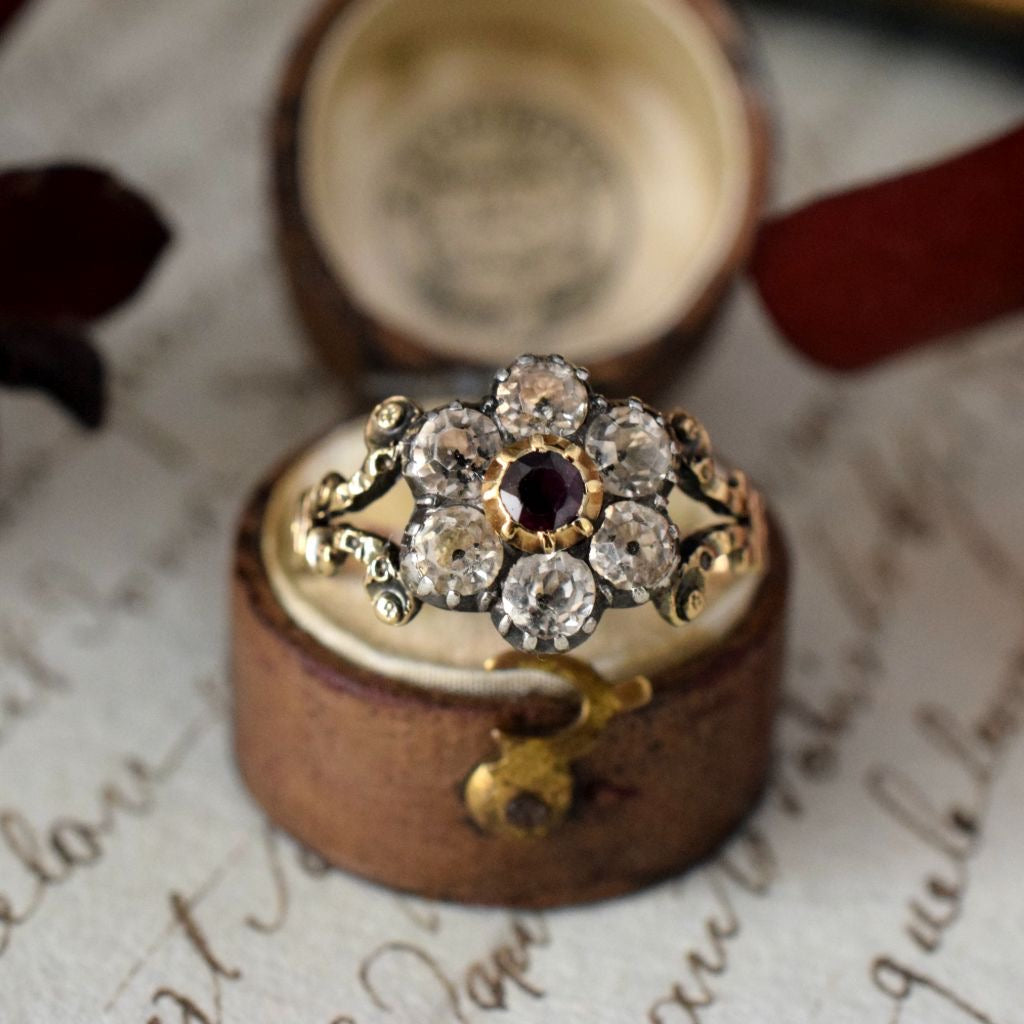
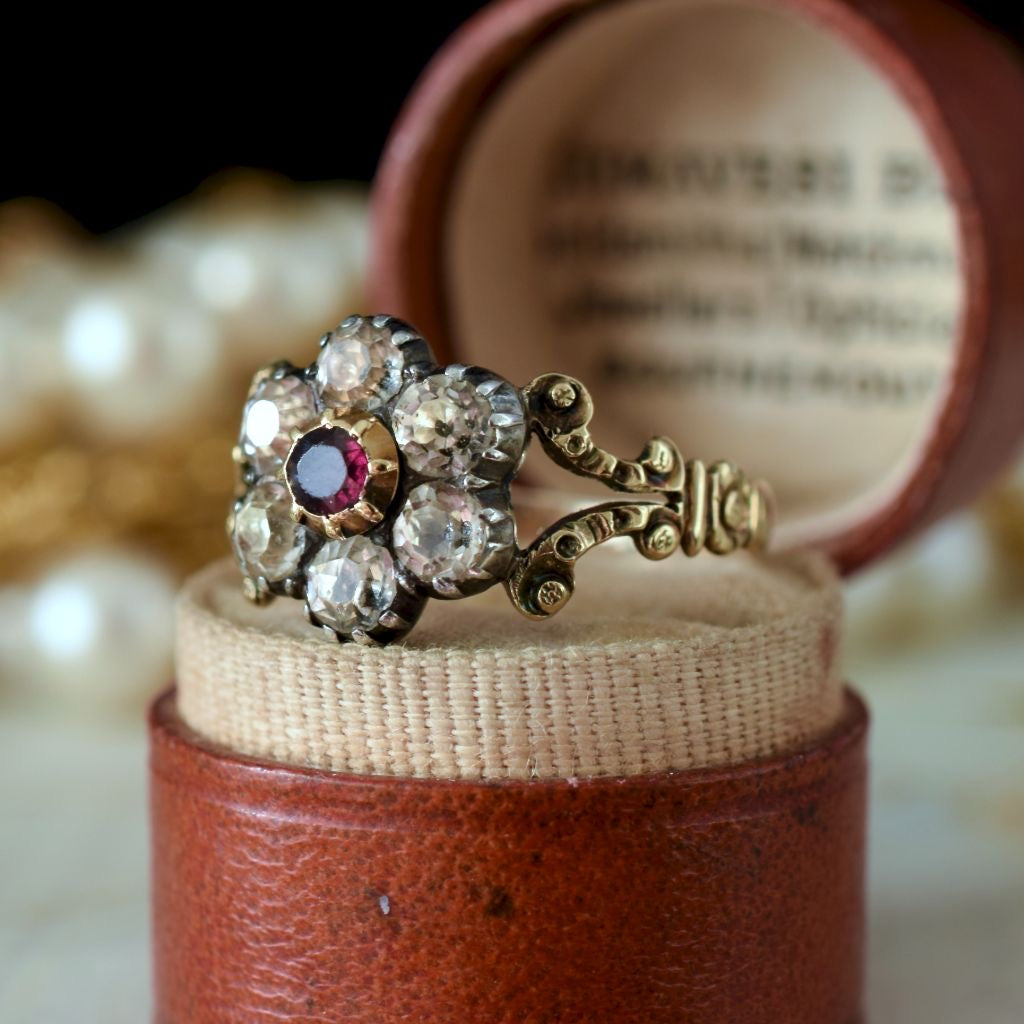
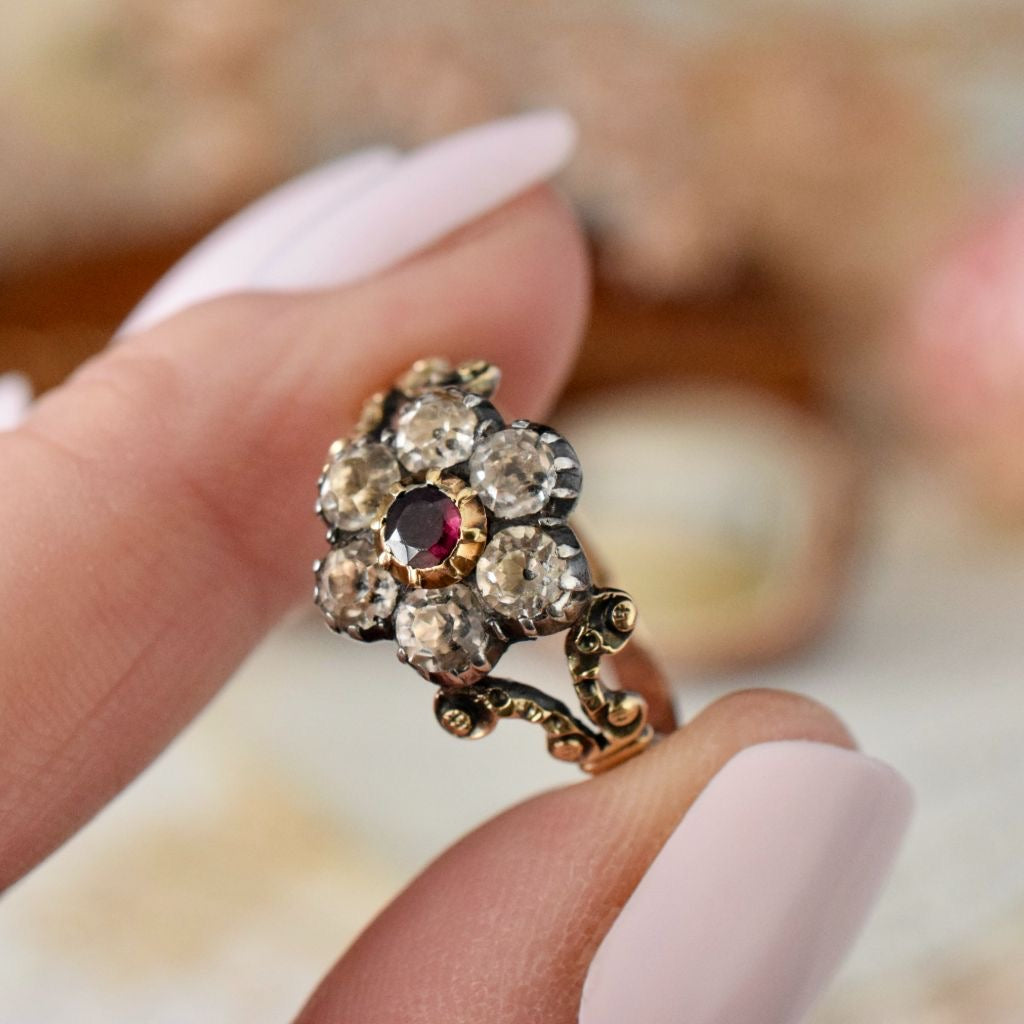

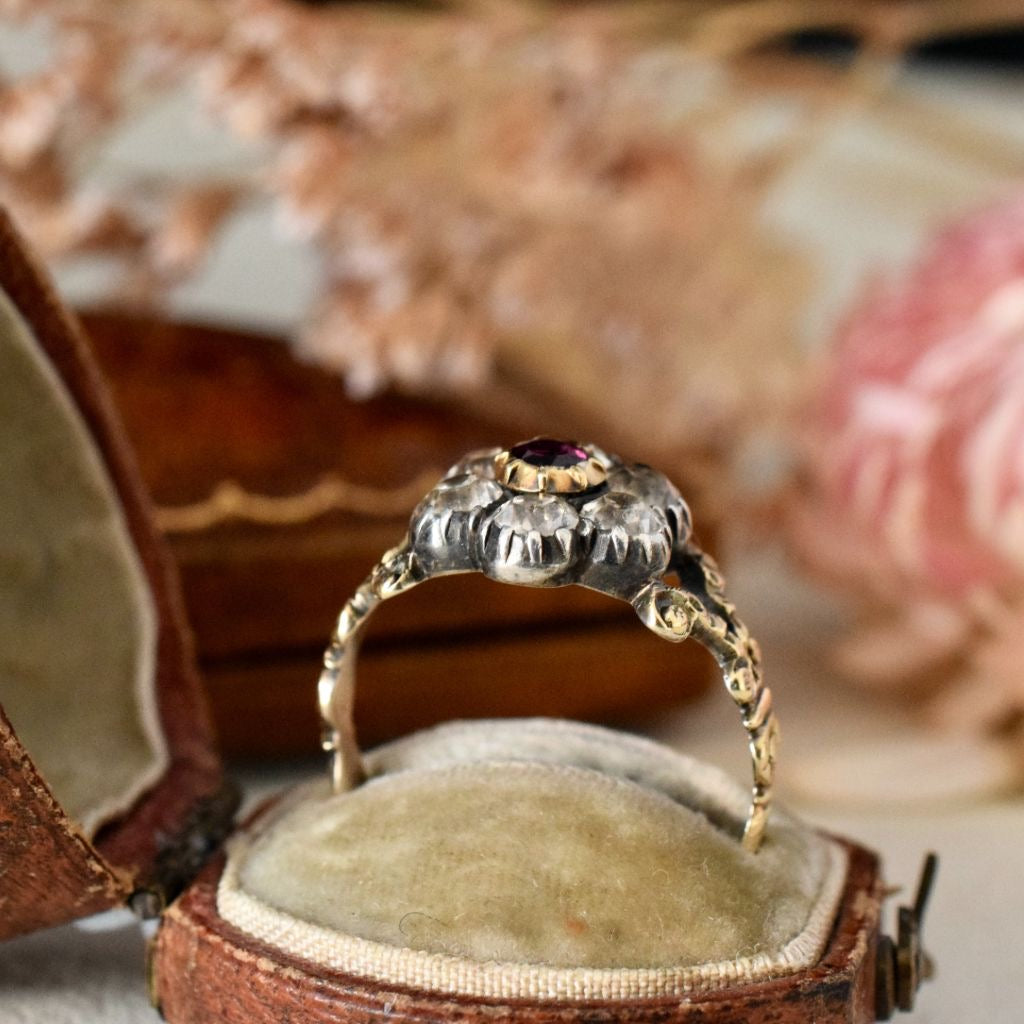
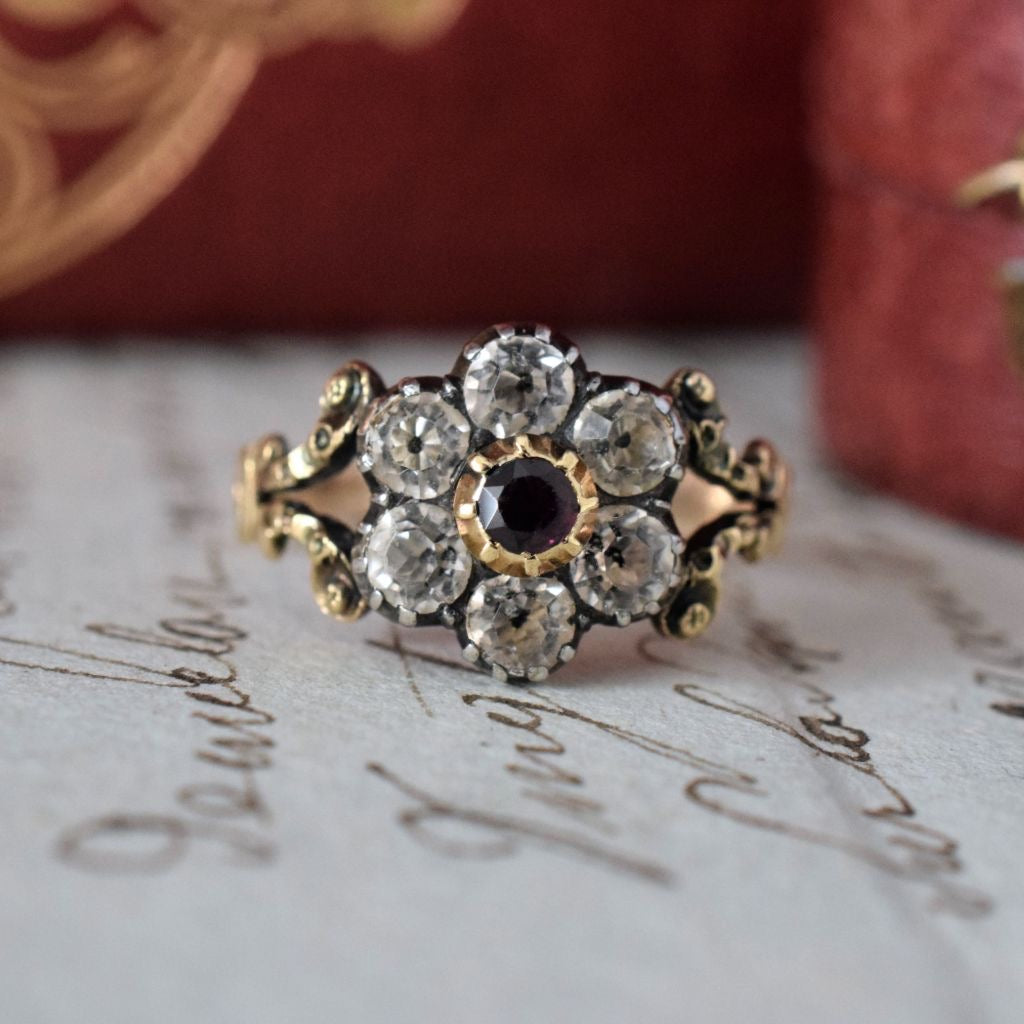
Georgian 18ct Yellow Gold ‘Daisy’ Cluster Paste Ring Circa 1820
Dating to around 1825 this quite amazing ring, for its 190 plus years, is possibly one of the prettiest examples of Georgian paste jewellery we have had the pleasure of offering.
Styled as a ‘daisy’ cluster with black-dot clear paste stones emulating diamonds, which surround the central gold set cut down collet paste garnet.
Black dot paste has a black dot painted to to bottom to emulate the open culet of early cut diamonds. This labour intensive production of the flint glass itself with the addition of the care and skill to paint these ‘dots’ is a hallmark of only the finest quality Strass glass.
As with the majority of most Georgian rings the setting is silver (except for the central red paste), closed backed to the verso however in gold.
The original ornate shoulders and shank have been tested to 18ct yellow gold.
In amazing condition for its age this ring has been treasured and obviously cared for through-out its very long life. Only very minor insignificant marks to the pastes all of which are original with no additions and secure in their cut down collet settings.
The beautiful shank is original and also with no repairs or reinforcements.
Superb early ring, a true testament to the skills of an early master jeweller.
STONES
Paste ( Flint Glass)
MEASUREMENTS
Daisy’ is 1cm
Shoulder to shoulder 2cm
WEIGHT
2.96 Grams
MARKS
None
Tests to 18ct for shank
Silver to upper setting
SIZE
Q or 18.3mm diameter or US 8 1/4
Not advisable to resize
CONDITION
Excellent antique condition for its 190 years plus. Very very insignificant marks to some pastes. All set very securely. Shanks is nice and strong with really no thinning. Previous resize can just be seen only under magnification, very well done. Lovely ring.
Paste is a special type of flint glass, an art form that originated during the Georgian era created by Georges Frederic Strass (1701-1773), who combined bismuth and thallium to improve the refractive quality of these imitation stones, altering their colours with metal salts.
These stones were so similar to real gems that he coined the term ‘ simulated gemstone’ to describe them. Strass would place metal foil behind the stone to emulate the real gemstones thus accentuating the brilliance.
His name is still attached to the craft with some people referring to fine-quality antique paste jewellery as ‘Stras’ (or "Strass") instead. Strass opened his own business in 1730, and devoted himself wholly to the development of imitation diamonds. Due to his great achievements, he was awarded the title "King's Jeweller" in 1734.
Georgian paste will often have a black dot painted on its culet to give it a sense of depth, referred to as “black dot” paste. Much of the beauty and appeal of antique paste jewellery is that it was such a difficult and labour-intensive thing to produce. The special paste glass was cut and polished by hand so that is shone and glittered.
Laybys & Hold Policy
Do you have your eye on a fabulous piece but need some extra time to
pay? At Graisons, we offer suitable layby terms for pieces priced $400 AUD and above. Contact us for more details.
Purchase Guide & Refund Policy
For information regarding our Purchase Guide & Returns Policy, please click here
Shipping & Delivery
Free Complimentary Express Shipping: Australia & Select International Countries.
We are pleased to offer free complimentary express postage, fully insured with tracking and signature on delivery using Australia Post.
Orders are dispatched within one-two business days of purchase. Once complete, a tracking number will be forwarded to you via email notification.
We are currently shipping to the following international countries:
UK, USA, CANADA, SINGAPORE, NEW ZEALAND, HONG KONG.
PLEASE NOTE: Any duties imposed by countries for importing our items are the buyers responsibility. Please contact your local customs agency if you wish to discuss potential rates and fees.
Caring For Antique & Vintage Jewellery
We absolutely pride ourselves on sourcing the best quality pieces for our customers, with many of our items valued by our registered jeweller/gemologist.
Our collection consists of pieces that are of antique and vintage condition, which means that all our items are secondhand and used. Customers are not purchasing 'new', 'perfect' and 'unworn items', and as such, should expect wear and imperfection. Any condition issues are always extensively mentioned in the condition summary.
Please do not hesitate to ask questions prior to purchase. It is the responsibility of the purchaser to ensure that these descriptions and pictures are carefully viewed and any questions are asked prior to the transaction taking place.
Please refer to our guide, Caring For Antique & Vintage Jewellery for more details.
Your Purchase: What Is Included?
Your purchase will be lovingly packaged in our custom made, eco-friendly Graisons Fine Jewellery Jewel box tied with ribbon inside our custom made packaging/mailing box.
For added safety and security, all purchases are shipped inside an Australia Post medium sized mailing box.
If your item includes an independent valuation, the physical certificate will be included.
Choose options





